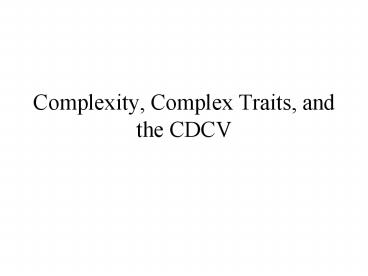Complexity, Complex Traits, and the CDCV - PowerPoint PPT Presentation
1 / 20
Title:
Complexity, Complex Traits, and the CDCV
Description:
RFLP (DNA polymorphism as marker) 1980. Chronic granulomatous ... but don't have top of pedigree. Most (~90%) Mendelian disease genes I.D.ed by. Linkage. ... – PowerPoint PPT presentation
Number of Views:85
Avg rating:3.0/5.0
Title: Complexity, Complex Traits, and the CDCV
1
Complexity, Complex Traits, and the CDCV
2
Simple Monogenic Diseases
- Mendel 1866
- Alcaptonuria (Garrod) 1902
- Sickle Cell Anemia I.D.ed (Herrick) 1910
- Pauling shows SC is molecular disease 1949
- RFLP (DNA polymorphism as marker) 1980
- Chronic granulomatous disease gene 1986
- How many monogenic disease genes do we have
today?
3
Common DNA Markers
- RFLP
- Sequence Tagged Site
- Microsatellite
- SNP
4
Linkage Analysis
A/A
a/A
a/A
A/A
a/A
A/A
a/A
5
Resolution can be a Problem
a
Disease allele
B
c
e
Case 1 no recombination Case 2 low
recombination Case 3 high recombination
Typical families can map to 1-10 cM or 1-10
MB (tens to hundreds of genes)
6
Possible Solutions
- Really Large Families
- Hard to find.
- Multiple families
- Different genes?
- Linkage Disequilibrium Studies in Isolated
Populations
7
Linkage Disequilibrium for Fine Mapping (board)
Typically use SNPs Haplotypes versus SNPs Founder
Effect Non-disease Haplotypes can reduce power In
some ways similar to Linkage, but dont have top
of pedigree Most (90) Mendelian disease genes
I.D.ed by Linkage.
8
Common Diseases
- Low penetrance!
- Multifactorial (environment, other genes)
- How many to date?
9
The common disease, common variant hypothesis
- Most variation in your genome is common
- 90 of alleles in your genome are common.
- Human population went through a recent
bottleneck. - Hypothesis Diseases that were evolutionarily
neutral during human history may be significantly
influenced by common variants.
10
The Hap Map and Association Studies
Board
Under what circumstances will this work?
11
Battle 1
12
From Reich and Lander (2001)
13
From Reich and Lander (2001)
14
From Reich and Lander (2001)
15
From Reich and Lander (2001)
16
Battle 2
17
What can we learn from Mendelian disease?
From Botstein and Risch 2003
18
How many common disease SNPs are there?
From Botstein and Risch 2003
19
Yeah, but does it apply to common diseases?
From Botstein and Risch 2003
20
Head to Head Comparison
From Botstein and Risch 2003































